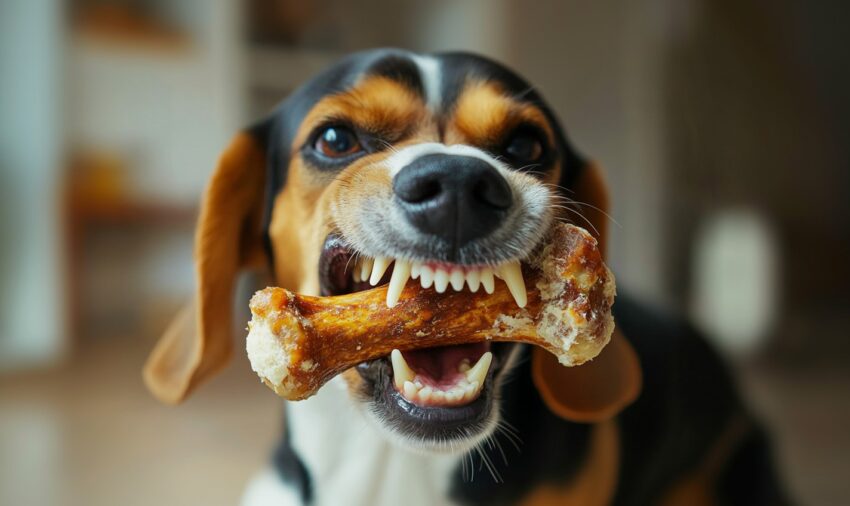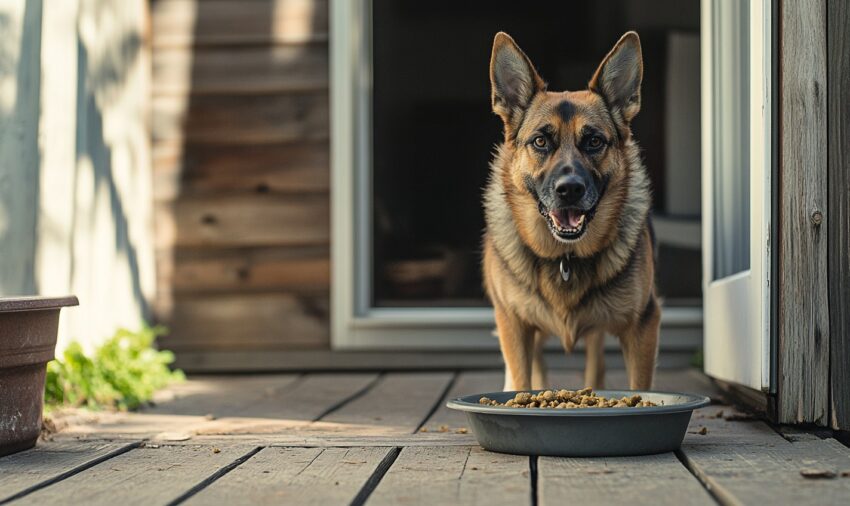Food aggression in dogs is a worrying problem, but it’s not an unsolvable problem. If your dog growls, clicks, or guards his food bowl like it’s a treasure chest, you’re not alone. This is a common behavior rooted in instinct, but with the right technique and a little patience, you can help your puppy feel safe and calm while eating.
In this article, we will explain in detail what a food attack is, its causes and, most importantly, how to effectively prevent and manage it. Whether you’re raising a puppy or working with an older dog, these tips will help you ensure calm mealtimes for the whole family.
What is food aggression in dogs?
Food aggression is a form of resource guarding in which dogs become defensive over food. This ranges from mild behaviors such as stiffening and growling to more serious behaviors such as lunging and biting. Although it may seem like “bad behavior,” it is often a natural instinct rooted in survival.
Food is scarce in the wild, so animals guard their diets to ensure they have enough to survive. Your dog probably doesn’t need to hunt for dinner, but this deep-rooted behavior can surface, especially if he feels anxious or threatened.
Signs of food attack
Before embarking on preventive strategies, it is essential to recognize the signs of a food attack. These may include:
- growl or growl when someone approaches the food.
- stiff body posture Eating.
- snap or lunge If someone gets too close.
- Eating fast It’s as if they are afraid of having their food taken away.
- action to protect, Such as standing over the food bowl and refusing to move.
Understanding these signals can help you address problems early and prevent them from escalating.
Why do food attacks occur?
Food aggression can be caused by a variety of factors, including:
- Fear of losing food: This is common in dogs that have experienced food insecurity, such as stray dogs or rescue dogs.
- competition: In multi-dog households, dogs may feel the need to protect their food from other dogs.
- Territorial instinct: Some dogs tend to be naturally protective of their belongings, including their food.
- Learned behavior: If your dog has had food taken away from him in the past, he may develop a tendency to be wary.
Here’s a little interesting side story. A few years ago, we had three dogs at the same time: Tasha, Maia, and Cooper. Of the three, Cooper likely had food aggression issues because he spent the first six months of his life in a small cage with 10 other puppies and didn’t get enough food. You might have thought so. He did have food, but anxiety He was never proactive on issues.
Maia, on the other hand, never felt hungry for even a moment. But when it came to food, she was a total “resource guardian.” She wasn’t exactly aggressive either, but she would collect the bowls and hoard them next to her the second Tasha and Cooper looked away. Therefore, food aggression (or its milder cousin, resource guarding) does not always follow expected patterns.
How to prevent food aggression in dogs
To prevent food aggression, it’s important to create a safe, positive environment in which your dog feels safe. Here are some proven strategies.
1. Start early with puppies
If you are raising puppies, this is the perfect time to prevent food aggression before it starts. Handle the food bowl gently, add treats during meals, and encourage positive interactions with people near the food.
- Practice feeding by hand: Hand-feed your puppy from time to time to show him that you are a source of food and not a threat to him.
- Introduce gentle interruptions. While your puppy is eating, calmly approach and add an expensive treat (such as chicken) to the bowl. This teaches them that it is good for people to be close to food.
From experience, this method works very well. To get the dog used to eating, we made it a habit to put our hand in it while he was eating. I’ve done this with all my dogs, right down to the German Shepherds I grew up with. Jake was so docile about food that as a toddler I could stick my hand in his mouth and take it out without blinking in amusement. I don’t know why I felt the need to do that. I was 2 years old, so maybe it seemed like a good idea at the time. 😀
2. Establish calm breastfeeding habits
Dogs thrive on routine, so a consistent feeding schedule can help reduce anxiety around eating. Follow these tips:
- Feed your dog in a quiet, secluded area to minimize distractions and stress.
- Use designated feeding spots for added predictability.
- Avoid staying on top of your dog while he eats, as this may make your dog nervous or defensive.
3. Teach basic commands
Training your dog to follow basic commands like “sit,” “stay there,” and “get out of there” will give you more control during meals. For example, teaching them to “leave me alone” allows them to safely interrupt security actions without escalating the situation.
4. Use positive reinforcement
Reward-based training is one of the most effective ways to change your dog’s behavior. Use positive reinforcement during meals to help your dog associate calm behavior with a reward.
- Reward good behavior: Praise your dog and give him a treat when he’s relaxed while eating.
- Desensitize gradually. If your dog is exhibiting mild wariness, try standing a few feet away from the bowl while eating. Take your time and slowly approach the other person, rewarding their calm demeanor.
5. Separate feeding area for multi-cat homes
If you have multiple dogs, feeding them in separate areas can prevent competition and reduce the chance of food attacks. Each dog should have their own bowl and a designated space where they can eat in peace.
- Use a baby gate, crate, or separate room if necessary.
- Remove the food bowl when your dog has finished eating to avoid post-meal guarding.
- Give each dog their own smart feeder (preferably an RFID feeder for each dog)
6. Avoid punishment
When dealing with food aggression, it is important to avoid punishment. Scolding or physically removing food can further intensify your dog’s fear of losing food, making the problem worse. Instead, focus on building trust through positive interactions.
7. Consult an expert if necessary
If your dog’s food aggression is severe or doesn’t improve after basic training, consider consulting a professional dog trainer or animal behaviorist. They can provide a customized plan to safely and effectively address the problem.

How to manage food aggression in older dogs
If your dog is already exhibiting food aggression, there’s no need to worry. It’s never too late to make progress. The same prevention strategies can help manage the behavior, but you should approach it slowly and patiently.
- Start from far away: If your dog reacts when you’re near the food, start by sitting a few feet away and gradually reduce the distance over time.
- Provide high-value rewards: To reward your dog for being calm when you’re near the food bowl, use treats that your dog will indulge in.
- Create a safe space. Make sure your dog has a quiet, safe eating area where he doesn’t feel the need to guard his food.
When to ask for help
Many cases of food aggression can be managed at home, but some may require professional intervention. If your dog’s behavior poses a safety risk or does not improve with training, consult a certified trainer or veterinarian.

conclusion
Although food aggression in dogs can be frustrating, it’s important to remember that it’s natural behavior and not a sign that your dog is “bad.” With the right techniques, you can help your dog feel safe and relaxed while eating, creating a happier, healthier relationship.
Start by understanding the root cause of aggression and address it using positive reinforcement, gentle routines, and consistent training. If you get stuck, don’t hesitate to reach out to a professional for guidance.
After all, mealtime should be a time of peace, not a battlefield. With patience and persistence, you will get there.





